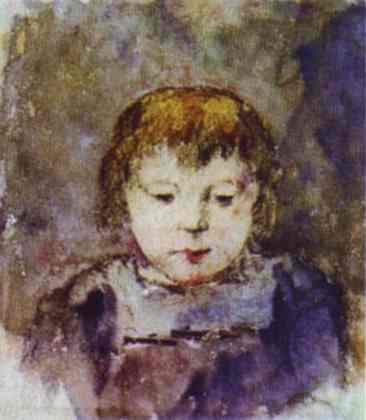Tanım
In "Portrait of Gauguin's Daughter, Aline" (1879), Paul Gauguin reveals an intimate and revealing facet of his personal and artistic life. The work, which depicts his daughter Aline, captures not only the essence of the family portrait, but also the search for a new way of seeing and feeling that characterized late 19th-century art.
The painting shows Aline sitting with a pensive expression, in a moment that seems suspended in time. The young woman is presented in a long, light dress, the lines of which flow in an almost ethereal way. This choice of clothing not only highlights the fragility of childhood, but also uses colouring that embodies the artist’s emotional sensitivity. The vibrant tones of the background contrast with the softer, muted tones of Aline’s outfit, creating an atmosphere that seems both protective and introspective.
Gauguin uses a palette that moves away from the traditional hues of European academicism, moving instead toward a bold use of color that prefigures post-impressionism. The brushstrokes are visible and deliberate, suggesting, rather than faithfully describing, Aline’s surroundings. The color scheme, which includes yellow, green, and blue hues, is used to evoke a sense of lightness and joy, while also introducing a subtle emotional complexity to the depiction of his daughter. The contrast between Aline’s pale face and the vibrant background brings the work to life, while her gaze directed toward a point out of sight lends it an air of innocence and curiosity.
It is not only a portrait of a girl, but also a reflection of Gauguin's worldview, marked by symbolism and the exploration of identity. In a period characterised by a break with tradition, Gauguin anticipated the trends of modern art by his ability to seek authenticity and personal truth in his work. Aline, in her stillness, becomes a symbol of this search, a silent witness to her father's emotional universe.
Despite the apparent simplicity of the composition, there is an underlying complexity that invites reflection and analysis. The relationship between the surrounding objects and the central figure is carefully constructed, suggesting an intrinsic connection between the subject and its environment. This visual dialogue highlights Gauguin’s talent for infusing emotional resonance into his portraits.
As part of Gauguin’s evolution as an artist, this work can be seen as a precursor to his later explorations in Tahiti, where he would continue to seek ways to capture the essence of his subjects through an even more radical use of color and form. Through “Portrait of Gauguin’s Daughter Aline,” one not only gains a personal glimpse of his life, but also begins to glimpse an artist in transformation, pushing the boundaries of what art could mean in a changing world.
The work is a testament to the emotional connection between a father and his daughter, while also reflecting a pivotal moment in the narrative of modern art. The sincerity in Aline’s depiction transcends the physical, inviting the viewer into the inner world of both the girl and her creator. This portrait is an elegant example of how art can capture the essence of human relationships, as well as the complexity of the artistic quest.
KUADROS ©, a famous painting on your wall.
Hand-made oil painting reproductions, with the quality of professional artists and the distinctive seal of KUADROS ©.
Painting reproduction service with satisfaction guarantee. If you are not completely satisfied with the replica of your painting, we will refund 100% of your money.

